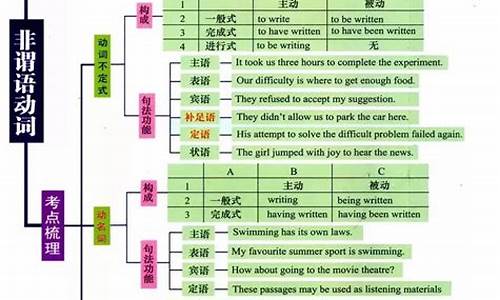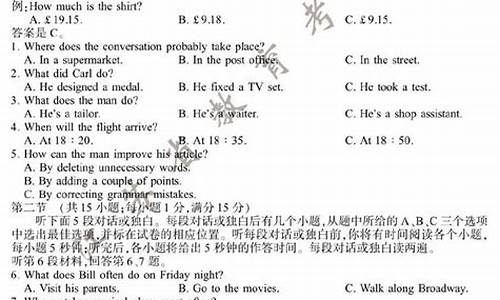您现在的位置是: 首页 > 教育趋势 教育趋势
非谓语动词的高考题,非谓语动词高考题题目及答案
tamoadmin 2024-06-04 人已围观
简介1.非谓语动词作状语的用法2.向高手提问一道有关英语非谓语动词的选择题(高中英语)!!!3.高中一道非谓语动词题4.高考英语非谓语动词考点讲析教案5.高考英语非谓语动词巧记巧用face表示朝向时,用法举例如下:The building faces the park.要表示“面对……”,以下两类表达均可用:一是 facing sth:该用法中的 facing 为及物动词 face 的现在分词,其后要
1.非谓语动词作状语的用法
2.向高手提问一道有关英语非谓语动词的选择题(高中英语)!!!
3.高中一道非谓语动词题
4.高考英语非谓语动词考点讲析教案
5.高考英语非谓语动词巧记巧用

face表示朝向时,用法举例如下:
The building faces the park.
要表示“面对……”,以下两类表达均可用:
一是 facing sth:该用法中的 facing 为及物动词 face 的现在分
词,其后要直接跟宾语(因为 face 是及物动词,所以要直接跟宾语,不能用介词 with)
二是 faced with sth:该用法中的 faced 为及物动词 face 的过去分词,在此具有形容词的性质,它后面不能再直接跟宾语,故要接上介词with。
c答案不定式的完成形态,现在分词(doing)的完成时(having done)所表达的时间观念是:后者表示的动作比主句动作早。例如:1,He is said to have gone abroad last week.据说,他上个星期出国了。(出国的动作发生在听说之前。)
2,Having spent most of his adult life in England,he became a British citizen in 1938.他在英国度过了他的成年生活的大部分时间,于1938年成了一个英国公民。(度过spend发生的比become早。)
本题不需要强调face这个动作在built之前,所以不选c。
非谓语动词作状语的用法
高考英语中非谓语动词试题的实用技巧:用作结果状语时,可用现在分词或不定式,其原则区别是:一般要用现在分词,不定式用作结果状语主要用于某些特定旬式中 。 技巧一 用作目的状语.原则上要用不定式
1.When asked why he went there,he said he was sent there — — for a space flight.(2007江西卷)
A.training B.being trained C.to have trained D.to be trained
解析J答案选D。由于被训练进行航空飞行是他被派往那儿的目的,所以要用不定式,因此可排除A和B。另外.由于“他”与“训练”之间为被动关系,故选D。
2.— — this cake,you’11 need 2 eggs,175g sugar and 175g flour. (2006广东卷)
A.Having made B.Make C.To make D.Making
解析答案选C。由于是表示目的,故要用不定式,句意为:为了要做这块蛋糕,你需要2只鸡蛋、175克糖和175克面粉
技巧二 用于名词后作定语时,使用非谓语动词的原则是:用不定式,表示动作尚未发生;用现在分词,表示动作正在进行;用过去分词,表示动作已经发生,同时表示被动意义
1.The Chinese are proud of the 29th Olympic Games in Beijing in 2008.2006四川卷.
A.hold B.holding C.held D.to be held
解析答案选D。由于2008年奥运会尚未举行,故要用不定式
技巧三 用作伴随状语.原则上要用现在分词
1.As the light turned green,I stood for a moment,not— — , and asked myself what 1was going to do. (2007湖南卷)
A.moved B.moving C.to move D.being moved
解析答案选B。由于与句子主语I之间为主动关系,且表示当时持续了一会儿,故用现在分词。句意为:当信号灯变绿时,我站在那儿一会儿没动,心想自己该怎么办
2.Peter received a letter just nOW — — his grandma would come to see him soon
A.said B.says C.saying D.to say
解析答案选C。此处用现在分词表伴随,又如:A card came yesterday saying Tom willarrive tomorrow.昨天收到的明信片上说,汤姆明天到。Alan received a telegram saying hisfather was il1.埃伦收到一封电报.说是他父亲生病了
3.W henever he was asked why he was late for class, he would answer carelessly,always— — the same thing. (2006江苏卷)
A.saying B.said C.to say D.having said
解析答案选A。现在分词saying在此表示伴随。
4. We often provide our children with toys, footballs or basketballs, that allchildren like these things.
A.thinking B.think C.to think D.thought
解析答案选A。现在分词thinking在此表示伴随。
技巧四 用作结果状语时,可用现在分词或不定式,其原则区别是:一般要用现在分词,不定式用作结果状语主要用于某些特定旬式中
1.The glass doors have taken the place of the wooden ones at the entrance,— — inthe natural light during the day. (2007天津卷)
A.to let B.1etting C.1et D.having let
解析1答案选B。此处用现在分词表示结果。又如:It rained heavily,causing severe 19flooding in that place.大雨滂沱,造成了那个地方洪水泛滥。
2.Oil prices have risen by 32 percent since the start of the year,— — a record us$57.65 a barrel on April 4. 一 (2005山东卷
A.have reached B.reaching C.to reach D.to be reaching
解析答案选B。伴随着谓语动词的发生而产生的自然结果,用现在分词作结果状语。 注:在en0ugh to do sth.,too---to do sth.,0nly t0 do sth.等特定句式中,习惯上要用不定语式表示结果 如:
1.He hun’led to the booking office only— —that al1 the tickets had been sold out.(2006陕西卷)
A.to tell B.to be told C.telling D.told
解析答案选B。only to do sth.在此表示出人意料的结果。
2.He hurried to the station only that the train had left. 2005广东卷
A.to find B.finding C.found D.to have found
解析答案选A。only to do sth.在此表示出人意料的结果。
技巧五 凡是含有被动意义时.原则上要用过去分词。但是.如果所涉及的动作尚未发生,则用不定式的被动式:如果所涉及的动作正在进行.则用现在分词的被动式
1.The children talked SO loudly at dinner table that I had to struggle — —.(2007浙江卷)A.to be heard B.to have heard C.hearing D.being heard
解析答案选A。根据句意,此处指的是“被听见”,故要用被动式,因此可排除B和c。另. .外。由于“设法被听见”为目的状语,动作在当时尚未发生,故用不定式,即选A。
2.The repairs cost a lot,but it’ money well— —.A.to spend B.spent C.being spent D.spending
解析答案选B。由于money与spend之间为被动关系,故用过去分词。
3.Five people won the “China’S Green Figure” award,a title — — tofor their contributions to environmental protection.A.being given B.is given C.given D.was given
解析答案选C。由于title与give之间为被动关系,故用过去分词。
技巧六 谓语动词作状语时,其逻辑主语原则上应与主句主语保持一致(2005湖北卷)
1.Faced with a bill for$10,000,— —. (2006陕西卷)A.John has taken an extra iob B.the boss has given John an extra iobC.an extra iob has been taken D.an extra iob has been given to John
解析答案选A。由于(be)faced with的逻辑主语是John,故答案只能选A。
2.W hile watching television,— —. 2005全国卷III
A.the door bell rang B.the doorbell ringsC.we heard the doorbell ring D.we heard the doorbell rings
解析答案选c。因为watching的逻辑主语一定是we,排除选项A和B;又因在hear后作宾补的是省略了to的不定式,所以选项D中的rings是错误的。
技巧七 强调动作发生在主句谓语动作之前时,原则上要用完成式(根据情况可用不定式的完成式或现在分词的完成式)
1. — — from other continents for millions of years, Australia has many plants and animals not found in any other country in the world. (2005湖北卷
A.Being separated B.Having separated C.Having been separated D,To be separated
解析答案选C。因为Australia与separate之间是被动关系,且separate发生在谓语动词has之前,所以用现在分词的完成被动式作原因状语
2.The manager,— — it clear to us that he didn’t agree with US,left the meeting room.f2005江西卷
A.who has madeB.having made C.made D.making
解析答案选B。因为The manager与make之间是主动关系,且make发生在谓语left之前,所以用现在分词的完成式作状语,having made.相当于who had made. 的意思。
技巧八对于固定搭配.原则上按搭配习惯处理
l、— — with SO much trouble,we failed to complete the task on time. 2006四川卷)
A.Faced B.Face C.Facing D.To face
解析答案选A。(be)faced with为固定搭配,其意为“面对”,又如:TheY are all facedwith the same problem.他们都面临同样的问题
2、— — in a white uniforln,he looks more like a cook than a doctor. 2005湖南卷)
A.Dressed B.To dress C.Dressing D.Having dressed
解析答案选A。(be)dressed in为固定搭配,其意为“穿着..”,句中的Dressed in.表原因.相当于As he is dressed in. 的意思
向高手提问一道有关英语非谓语动词的选择题(高中英语)!!!
非谓语动词作状语用法详解
作状语是非谓语动词的主要功能之一。正确运用非谓语动词作状语是考生必须掌握的最基本英语语法知识之一,也是NMET及其同等水平考试常见考查内容。笔者这里结合一些常见例题谈谈此方面语法知识的复习。
一、不定式作状语
不定式作状语常常考查的有以下三方面知识:
⒈不定式作目的状语 一方面不定式可以独立作目的状语;另一方面不定式还可以用在so as (to) 或 in order (to) 后,表示目的。从结构上讲,不定式作目的状语放于句首时,通常用逗号和句子隔开;如果放于句末,通常不用逗号:
名题1 (2003北京海淀区高三第二学期期中练习 · 26)
_____ their service, the workers of the hotel are active in learning English.
A. Improving B. To improve C. Improved D. Having improved
解析 本题考查非谓语动词作状语。不定式放于句首,说明了酒店员工积极学习英语的目的。答案为B。
名题2 (2003北京东城区高三总复习练习(一)· 26)
______ time and labour, cartoonists generally draw the hands of their characters with only three fingers and a thumb.
A. To save B. Saved C. Saving D. Having saved
解析 本题考查非谓语动词作状语。不定式放于句首,说明了漫画家在画人物的手指时为什么只画三个手指和一个大拇指。答案为A。
名题3 (’99SHMET · 18)
—Mum. Why do you always make me eat an egg every day?
—_______ enough protein and nutrition as you are growing up.
A. Get B. Getting C. To get D. To be
解析 本题考查非谓语动词作状语。分词作状语可以表示时间、原因、条件、伴随情况;不定式作状语多表示目的和结果。问句以why 开头,暗示了要用非谓语动词作目的状语。作目的状语的不定式可用in order to 来引起;有时为了强调,也常常放在句首。答案为C。
2.不定式作结果状语 不定式作结果状语时放于句末,其前面时常有副词only(In the last analysis or final outcome:—最后的分析,最终结果:):
名题4 (2004陕西省高三调研题 · 27)
The American troops tried many times to break into the mosque, _______each time.
A. beaten back B. only to be beaten back
C. being beaten back D. having been beaten back
解析 本题考查动词不定式作结果状语。A项为过去分词,其基本属性是表示“一个早于谓语动词而发生的被动动作”,通常说明谓语动词发生背景;C项为现在分词的被动体,其基本属性是表示“一个和谓语动词同时发生的被动动作”,但这种形式一般不用于作状语;D项为分词完成体的被动形式,用以强调该被动动作在位于发生之前已经完成。答案为B。
3.不定式作原因状语 用作原因状语的不定式一般放于句末,偶尔也见于句首。说明谓语动作或状态产生的原因:
名题5 (2001陕西省高三调研题(一) · 27)
We all jumped with great joy ______ the news that our country would have joined WTO by the end of the year.
A. hearing B. to have heard C. being heard D. to hear
解析 本题考查动词不定式作原因状语。现在分词放于句末作状语时,一般要用逗号和句子隔开;根据题干可以看出这里只说明高兴得跳起的原因,而不是动作是否已经完成。答案为D。
不定式的这种用法常见于表示人的心理感受的形容词作表语的句式中。这类形容词常见的有:happy, glad, sorry, lucky, fortunate, unfortunate, ashamed, surprised, frightened, shocked, delighted, disappointed, anxious, impatient, foolish, rude, cruel, wrong, considerate, prompt, etc. 如:
⑴ Many people are eager to take part in the coming Olympic Games.
⑵ We shall be happy to co-operate with you in the work.
⑶ I was annoyed to hear them talk like that.
二、现在分词作状语
使用现在分词作状语时,分词动作的执行者必须是句子的主语。通常有以下三种题型:
1.作伴随状语,表示分词动作同句子谓语动词所表示动作同时进行:
例题6 (2002天津市高三模拟试题(二) · 29)
______ the merry tune, Jack fixed the tire.
A. Whistling B. To whistle
C. Whistled D. Having been whistled
解析 题干中的the merry tune作非谓语动词的宾语,所以排除表达被动意义的C, D两项;不定式放于句首只能作目的状语;现在分词放于句首时,可以作伴随状语,说明“杰克一边吹这欢乐的小调,一边装这轮胎”。答案为A。
但也有相当一部分只能放句子后面,都可以放:
例题7 (2004陕西省高三调研题 · 31)
All night long he lay awake, _______ how to drive the American invaders back home.
A. to think B. thinking C. thought D. being thought
解析 现在分词作伴随状语。(译文: 他彻夜未眠,思量着如何把美国鬼子赶回家。)答案为B。
2.作原因状语。例如:
名题8 (2003南昌高三测试题 · 26)
______good , the food was sold out soon.
A. Tasting B. Tasted C. Being tasted D. Having been tasted
解析 taste 可作系动词,所以没有被动形式。C项是现在分词一般体的被动形式,表示一个和句子谓语同时进行的被动动作;D项是动名词完成体的被动形式表示一个早于谓语动词的被动动作,但动名词不可以作状语。作状语时,如果要表示一个早于谓语动词的被动动作,用过去分词即可。答案为A。
名题9 (2004南阳市高三第二次模拟试题 · 34)
—A traffic jam?
—Oh, no. _______, the right side of the road is closed for the time being.
A. To be repaired B. Being repaired C. Repaired D. Having repaired
解析 句子的主语是the right side of the road,它和非谓语动词“维修”之间属被动关系,所以排除D;而C过去分词虽然也表示被动,但在时间上却早于句子的谓语;A项虽为被动,但表示的是将来,只说明暂时封闭的目的;B项说明路正在维修,作原因状语。答案为B。
现在分词短语作原因状语,尤其见于be,feel,know,recognize,fear等状态动词的现在分词(短语),以及现在分词的否定式用作状语时。例:
⑴ Seeing the door locked, he realized that he would have to turn back in vain again.
⑵ Not knowing her address, I can’t write to her to express my gratitude to him.
⑶ Not having finished her work, she had to work extra hours.
⑷ They sent us their statement, hoping to get our support.
3.作时间状语,相当于when 引起的从句:
名题10 (2003天津市重点中学联考题 · 34)
______the big snake, the little girl stood under the tree _____ out of her life.
A. Seeing; frightened B. Seeing; frightening
C. Seen; frightened D. To see; frightening
解析 首先小姑娘看见蛇说明see 和句子的主语是主动关系;C项是过去分词,其根本属性是表示被动,表示一个在句子谓语发生之前已经发生的一个被动动作;D项虽然表示了和主语之间的主动关系,但不定式的根本属性是表示将来。所以,C, D均可排除。而frightened (受惊的)作状语说明了主语受惊后的状态;frightening (令人恐惧的)说明主语的特点。答案为A。
名题11 (2004太原市高考模拟试题 · 26)
_______ to her apartment, she found her necklace missing.
A. To return B. Returned C. Being returned D. Returning
解析 题中的return意为“返回”,因而不可能有被动形式;不定式放于句首通常只能是作目的状语,因此不和题义。而这里现在分词放于句首相当于一个由when连接的时间状语从句,表示这动作一发生,谓语表示的动作立即发生。答案为D。
如果两个动作是同时发生,多用when或while加分词这种结构,例:
⑴ Be careful when crossing the street.
⑵ When leaving the room, she forgot to lock the door.
⑶ She got to know them while attending a conference in Beijing.
⑷ Don’t mention this while talking to him.
4.如果分表示的动作发生于谓语所表示的动作之前,就用分词的完成体:
名题12 (2001NMET · 35)
______ such heavy pollution already, it may not be too late to clear up the river.
A. Having suffered B. Suffering C. To suffer D. Suffered
解析 本题考查非谓语动词作状语。按照传统语法,现在分词作状语,其逻辑主语必须和句子的主语相一致,但这里分词的逻辑主语是river(作宾语),又有already 提示“suffer”发生在谓语之前,故用现在分词完成体作状语。答案为A。
名题13 (2003广州市高三调研题 · 27)
______a seat, she left her books on it.
A. Found B. Finding C. To find D. Having found
解析 根据题义,只有找到座位,才可以把书本放在上面。只有现在分词的完成体D才说明了“find”发生在谓语动作发生之前。答案为D。
三、过去分词作状语
过去分词作状语,用来说明谓语动作发生的背景或情况,通常有以下几种题型:
1.作原因状语,相当于一个原因状语从句:
名题14 (2003辽宁省重点中学连考题 · 35)
______ , the young man is healthy and strong..
A. Fully developed B. Fully growing C. Full developing D. Full grown
解析 本题考查非谓语动词作状语。首先,分词前要用副词来修饰;其次,grow是不及物动词,可以说grow quickly(长地快)、grow old (变老),但fully growing就不和逻辑了。而develop vt (使发展)。A和句子的主语是被动关系,说明了该年轻人身体强健的原因是因为得到了全面发展。答案为A。
名题15 (2004昆明市高三模拟试题 · 28)
______ in thought, he almost ran into the car in front of him.
A. Losing B. Having lost C. Lost D. To lose
解析 Lose 是及物动词, 意思是“专心致志于…”, 后接反身代词; lost in thought源于lose oneself in thought。答案为C。
2.表示一个假设情况,相当于一个条件从句:
名题16 (2002辽宁省重点中学连考题 · 25)
______ in this way, the situation doesn’t seem so disappointing...
A. To look at B. Looked at C. Looking at D. To be looked at
解析 题中的look at 是及物动词,而句子的主语situation 和 look at 只能是被动关系;D项虽为被动体,但不定式放于句首时只能作目的状语,其语法功能和题义不符。答案为B。
名题17 (2003太原市高三统一练习题(三) · 30)
_______ with developed countries, we still have a long way to go.
A. To compare B. Compared C. Comparing D. Being compared
解析 本句可以转换为复合句“If we are compared with developed countries, we still have a long way to go.”由此得知句子的主语we和compare之间属于被动关系,所以要用过去分词。答案为B。
4. 一般情况下非谓语动词作状语时,要求非谓语动词表示的动作和谓语动词的主语相同,但也有少数分词短语实际上已经成为固定结构,表示说话人对说话内容所持的态度。如:
名题18 (2000高考春招 · 17)
______the general state of his health, it may take him a while to recover from the operation.
A. Given B. To give C. Giving D. Having given
解析 given在此意为“鉴于”、“考虑到”。这种评说性的独立成分作状语,其逻辑主语不要求和句子的主语保持一致。这种情况下,分词短语的逻辑上的主语和句子的主语是不一致的,可以看作是一种独立成分.例:
⑴ Judging from what you say, he ought to succeed.
⑵ Considering his age, the child reads well.
⑶ Taken as a whole, there is nothing wrong.
⑷ Given their inexperience, they have done a good job.
答案为A。
5. 分词作状语时,有时前面可以加上一个连词。连词than, as, once, if, unless, though, even if等之后,均可以接一个过去分词作状语,这时,分词的逻辑主语是分词的动作对象。
名题19 (2002NMET
The research is so designed that once _______nothing can be done to change it.
A. begins B. having begun C. beginning D. begun
解析 :本题考查的是过去分词作条件状语从句时的用法.在这儿once begun可换成once it is begun,故最佳答案是D项.
名题20 (2002上海春招)
When _______, the museum will be open to the public next year.
A. completed B. completing C. being completed D. to be completed
解析该题考查过去分词充当时间状语的用法.同样把when completed还原成when it is completed便可知最佳答案为A.
名题21 (2002合肥市高三第二次抽样考试 · 28)
______ who she was, she said she was Mary’s cousin.
A. Asked B. When asked C. When asking D. Asking
例:⑴ Once recovered, he went all out to do his work.
⑵ Though beaten by the opposite team, the players didn’t lose heart.
⑶ If carefully done, the experiment will be successful.
要学习掌握非谓语动词作状语,就必须牢记不定式、现在分词和过去分词的基本属性,并据此从句子的整体结构去理解句子的含义。只有这样,才能有效地排除干扰项,并作出正确选择。
高中一道非谓语动词题
这里应该是现在分词形式作为目的伴随状语
The old man devoted all his money to this school ,enabling these students to have a better study environment.
老人把所有钱都捐了,伴随着他希望让孩子有更好学习环境这一目的。
例如The students entered the classroom, following the teacher.
也是现在分词作伴随状语,表示学生是怎么进去的,是伴随着一个怎样的状态进去的
而且当动作是主语主动发出的,用Ing形式,是被动的,用ed形式
the teacher entered the classroom, followed by the students. 被跟着
in order to, to do sth。 so as to do sth. 都表示目的
一般如果是出现在句中的,都是没有逗号的
The old man devoted all his money to this school to enable/ in order to enable / so as to enable these students to have a better study environment.
而当放在句首时,是有逗号的
In order to enable/ To enable these students to have a better study environment, the old man devoted all his money to this school . (so as to只能放句中)
ing形式貌似没有表示目的的。。。 除非这种目的伴随状语吧
to do sth. 和doing sth.一般是在这些方面转换
总的来说,to do sth.是动词的不定式,doing sth.是动名词形式
很多情况是可以转换的,意思差不多,不过运用到的语法知识有时候稍微有点不同而已
it is adj. to do sth./ doing sth. 不定式/动名词作为真正主语,it是形式主语
to do sth./ doing sth. is adj. 不定式/ 动名词作主语
sb. like to do sth./ doing sth. 不定式/动名词作宾语
很多情况是用法差不多的,但是有些特殊用法,只能使用其中一种,那类型的要自己积累了~~
如只有feel like doing sth. 想做某事
还有那些 regret to do, regret doing sth
remember/ forget to do . remember/forget doing sth. 这种意思完全不一样的
多看看慢慢会有感觉的~~
高考英语非谓语动词考点讲析教案
his new house is like a huge palace,compared with his old one.
这句话意思是:相比起他的老房子,新房子像一个巨大的宫殿。
在解非谓语时,首先要看非谓语要用主动还是被动,找到compared是非谓语,his new house 是主语,那么“his new house”是被比较了,才像一个巨大的宫殿,“his new house”是不会主动比较老房子的,因为“compared”这个动作应该是“he”发出的。
高考英语非谓语动词巧记巧用
1. I send you 100 dollars today, the rest _____ in a year.
A. follows B. followed C. to follow D. being followed
剩余的将在一年还清,所以选C
2. _____from other continents for millions of years, Australia has many plants and
animals not found in any other country in the world.
A. Being separated B. Having separated
C. Having been separated D. To be separated
做原因状语,应为被隔离开很久,所以选C
1. The repairs cost a lot, but it’s money well_____.
A. to spend B. spent C. being spent D. spending
分析答案选B。因money与spend是被动关系,所以用过去分词。
2. The prize of the game show is$30000 and an all expenses _____ vacation to China.
A. paying B. paid C. to be paid D. being paid
分析答案选B。因all expenses与pay是被动关系,故用过去分词。注意句中的an 不是修饰 expenses,而是修饰vacation。
3. When _________help, one often says, “Thank you.” Or “It’s kind of you.” (福建卷)
A. offering B. to offer C. to be offered D. offered
分析答案选 D。因一个人说“谢谢”,应当是他被提供了帮助,所以要用过去分词,When offered help… =When he is offered help…
1. The storm left, _________a lot of damage to this area. (全国卷I)
A. caused B. to have caused C. to cause D. having caused
分析答案选D。因The storm与cause是主动关系,排除选项A;不定式作状语,前面通常不用逗号,排除B和C;因暴风雨给这个地区“造成损失”是在“结束”之前,所以用完成式。
2. More and more people are signing up for Yoga classes nowadays, _________ advantage of the health and relaxation benefits. (上海卷)
A. taking B. taken C. having taken D. having been taken
分析答案选 A。因people与take advantage of是主动关系,排除选项B和D;take不会发生在谓语are signing up之前,不用完成式,排除C。
1. “You can’t catch me!” Janet shouted, _________away. (全国卷III)
A. run B. running C. to run D. ran
分析答案选B。现在分词作伴随状语。
2. He glanced over at her, _________ that though she was tiny, she seemed very well put together. (广东卷)
A. noting B. noted C. to note D. having noted
分析答案选 A。因为he与note是主谓关系,且note与谓语动词glanced的动作同时发生,所以用现在分词的一般式作伴随状语。
3. Daddy didn’t mind what we were doing, as long as we were together, _________fun. (重庆卷)
A. had B. have C. to have D. having
分析答案选 D。用现在分词表伴随情况。
说明:有时过去分词也可表伴随(注意过去分词同时还表被动关系),但高考很少考查此用法。如:
He came in, followed by his wife. 他走了进来,后面跟着他的妻子。
在通常情况下,用作目的状语只能是不定式。如:
1. “Can the project be finished as planned?” “Sure, _________it completed in time, we’ll work two more hours a day.” (福建卷)
A. having got B. to get C. getting D. get
分析答案选 B。作目的状语只能用动词不定式。
2. _________ more about university courses, call (920) 746-3789. (浙江卷)
A. To find out B. Finding out C. Find out D. Having found out
分析答案选 A。作目的状语要用动词不定式。
3. It was unbelievable that the fans waited outside the gym for three hours just _________a look at the sports stars. (上海卷)
A. had B. having C. to have D. have
分析答案选 C。“看看体育明星”是“在体育馆外等三个小时”的目的,作目的状语只能用动词不定式。
1. 用现在分词表结果。如:
He fired, killing one of the passers-by. 他开枪了,打死了一个过路人。
Oil prices have risen by 32 percent since the start of the year, _________a record US $ 57.65 a barrel on April 4. (山东卷)
A. have reached B. reaching C. to reach D. to be reaching
分析答案选B。伴随着谓语动词的发生而产生的自然结果,用现在分词作结果状语。
2. 用不定式表结果。如:
He returned home to find his wife waiting for him. 他回到家发现他的妻子在等他。
He hurried to the station only _________ that the train had left. (广东卷)
A. to find B. finding C. found D. to have found
分析答案选 A。因为only to do是习语,意为“结果却,不料”,hurried和find是先后发生的两个动作。
高考英语非谓语动词巧记巧用
一、接不定式和接动名词意义不同的动词和短语
在下列8个动词和短语动词后接不定式和接动名词意义不同:
remember to do(记住去做) remember doing(记得做过)
forget to do(忘记去做) forget doing(忘记做过)
regret to do (遗憾地做) regret doing(后悔做了)
try to do(设法做) try doing(试做)
go on to do(接着做另一事) go on doing(继续做同一事)
mean to do(打算做) mean doing(意味着)
stop to do(停下来去做) stop doing(停止做)
can’t help to do(不能帮助做) can’t help doing(情不自禁做)
1. —You were brave enough to raise objection at the meeting.
—Well, now I regret ________ that. (全国卷)
A. to do B. to be doing
C. to have done D. having done
分析答案选D。由语境可知“我”“后悔”在会上提出异议,应接动名词。
2. —The light in the office is still on.
—Oh,I forgot ________. (全国卷)
A. turning it off B. turn it off
C. to turn it off D. having turned it off
分析答案选C。表示忘记做某事,事情还没做,forget后接不定式。
3. In some parts of London, missing a bus means ________ for another hour. (上海卷)
A. waiting B. to wait
C. wait D. to be waiting
分析答案选A。由语境可知句中的mean表示“意味着”,后接不定式。
4. She reached the top of the hill and stopped ________ on a big rock by the side of the path. (全国卷)
A. to have rested B. resting
C. to rest D. rest
分析答案选C。休息是停下来的目的,且发生在stop之后,用接不定式的一般式。
5. Go on ________ the other exercise after you have finished this one. (全国卷)
A. to do B. doing
C. with D. to be doing
分析答案选A。表示做完一事后“接着做”另一事,go on后接不定式。
二、表示未成实现的愿望或打算的动词和短语
表示未曾实现的愿望或打算,即表示“本打算 / 想 / 希望做某事”但事实上却没做的事情,用plan, intend, mean; want, hope, wish, expect等动词的过去完成时,加不定式的一般式,或者这类动词的一般过去时,加不定式的完成式;was / were, would / should like加不定式的完成式;was / were going加不定式的一般式。如:
I would love ________ to the party last night but I had to work extra hours to finish a report. (全国卷)
A. to go B. to have gone
C. going D. having gone
分析答案选B。由句意可知,是表示过去未曾实现的期望,用“would love+不定式完成式”。句意是:昨晚我本想去参加聚会的,但是…(from www.nmet168.com)
三、要接动名词的含有介词的常用句型
在介词后一般用动名词,下面是一些含介词的固定句式(其中有的介词有时会被省略):prevent / stop / keep sb. / sth. from doing (阻止…做…);spend / waste time or money in doing (在做…方面花费 / 浪费时间或金钱);How / What about doing sth. (做…怎么样?);have some difficulty / trouble in doing (在做…方面有些困难);have a hard time in doing sth. (做某事很艰难); there is no sense in doing(做…是没有理由 / 道理的);thank (excuse / admire / praise / blame / scold / punish) sb. for doing sth. (因做某事而感谢 / 羡慕 / 表扬 / 责备某人)等。如:
1. Having been ill in bed for nearly a month, he had a hard time ________ the exam. (福建卷)
A. pass B. to pass
C. passed D. passing
分析答案选D。因为have a hard time (in) doing sth. 在做某事方面有困难。
2. According to a recent U. S. survey, children spend up to 25 hours a week ________ TV. (上海卷)
A. to watch B. to watching
C. watching D. watch
分析答案选C。spend some time (in) doing sth. 做某事花了多长时间。
3. I believe that’s the best way to prevent such a thing ________ again. (全国卷)
A. to happen B. from happening
C. happened D. happen
分析答案选B。prevent sb. / sth. from doing 阻止…做…。
4. Did you have trouble ________ the post office? (全国卷)
A. to have found B. with finding
C. to find D. in finding
分析答案选D。have difficulty / trouble (in) doing sth. 在做方面有困难。
四、to是介词的常用固定结构
to是介词和固定词组很多,常见的有:look forward to(盼望), devote…to / be devoted to(致力于), be / get used to(习惯), lead to(导致), get down to(开始认真), pay attention to(注意), refer to(谈到), point to(指向), turn to(转向), object to(反对), equal to(等于、能胜任), belong to(属于)等。如:
1. Mr. Reed made up his mind to devote all he had to ________ some schools for poor children. (上海卷)
A. set up B. setting up
C. have set up D. having set up
分析答案选B。devote…to…中to是介词,接动名词;all是devote的宾语,he had是省略了关系代词that的定语从句。
2. The discovery of new evidence led to ________. (上海卷)
A. the thief having caught B. catch the thief
C. the thief being caught D. the thief to be caught
分析答案选C。lead to中的to是介词,后接动名词;逻辑主语the thief与catch是被动关系,所以用动名词的被动式(from www.nmet168.com)。
3. She looks forward every spring to ________ the flower-lined garden. (上海卷)
A. visit B. paying a visit
C. walk in D. walking in
分析答案选D。look forward to中to是介词,后接动名词。再说,若visit用作名词,后面要加介词to,才可接宾语,排除A和B;walk作名词,表示散步,仅用于go for / take / have a walk等结构,排除C。









